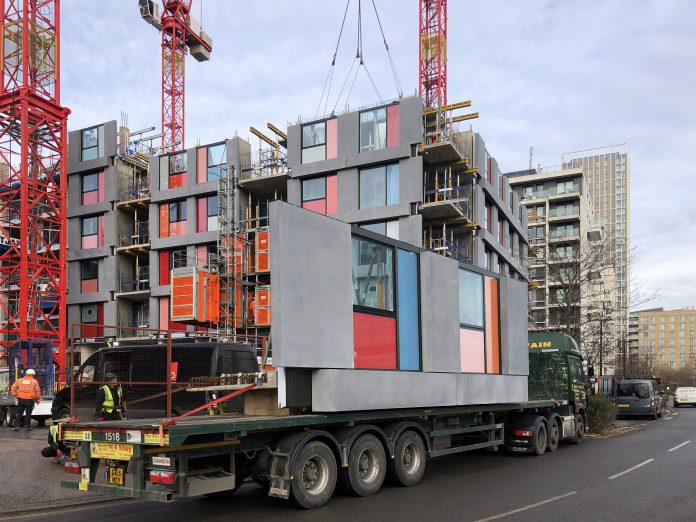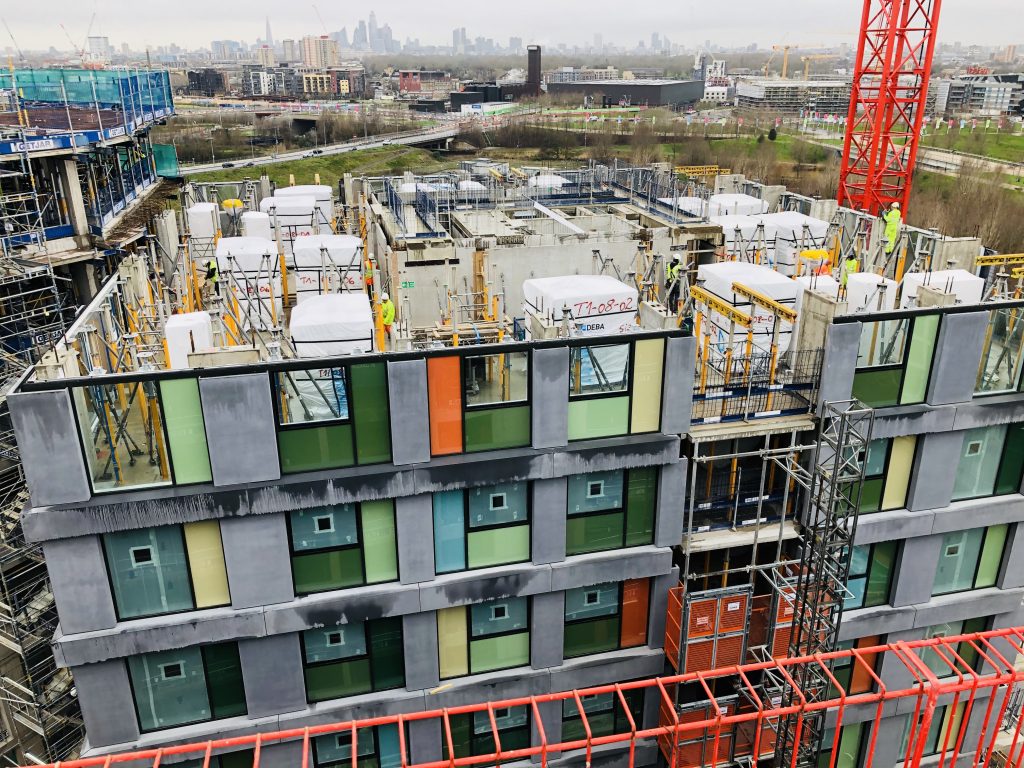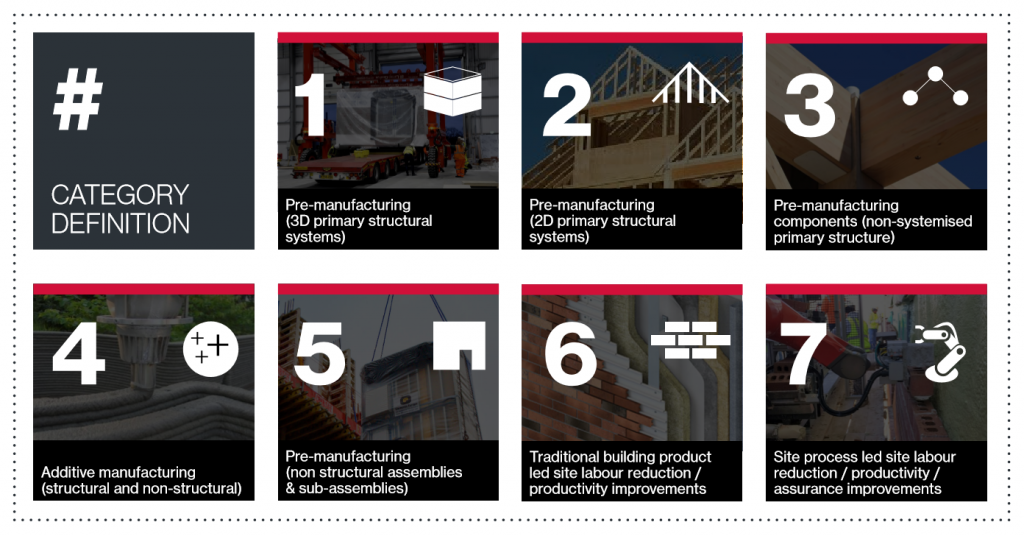The construction industry is facing a number of potentially existential challenges that need to be addressed urgently and offsite has the potential to make a significant contribution. But there is concern in some quarters about the aesthetic and built quality of some offsite developments and this concern needs to be tackled head on, says Nigel Ostime of Hawkins\Brown Architects
Modern Methods of Construction (MMC), implemented through the process of design for manufacture and assembly (DfMA) and facilitated through digital technology, can deliver exceptional quality as well as efficiency, and are surely the future, but must be gone about in the right way.
So what are the challenges?
Flatlining productivity
In the two decades up to 2015, productivity in manufacturing nearly doubled, while in construction it virtually flatlined (McKinsey report Reinventing Construction, 2017) and there seems to have been no significant change in the five years since. This lack of productivity and the industry’s insistence on race to the bottom, cost-led procurement has kept margins low and inhibited the necessary inward investment required to improve.
Construction 2025
In 2013, the government published the Construction 2025 Challenge for the industry to achieve 33% lower costs (in construction and whole life), 50% faster delivery (from inception to completion) and 50% lower emissions. These targets are tough but were considered achievable with the proviso of step-changes in procurement and design and construction processes and the introduction of DfMA. Seven years on, and with five to go, it seems unlikely we will meet this challenge by the deadline but we cannot afford to stop trying.
Skills shortage
The influential Farmer Review of 2016 highlighted the impending skills shortage brought about by demographic intransigence: an ageing workforce not being replaced by new entrants. Farmer contrasted the undesirable workplace of the archetypal muddy building site against the comfort of a factory environment, with the potential for a lower-skilled, more diverse workforce. Without this change, our industry will suffer from being further relegated down the career tables, increasingly viewed as the route for those who couldn’t get into something else. And the quality of the built environment will deteriorate.
Climate emergency
The biggest challenge, of course, is to reduce – and ultimately eliminate – carbon and waste. Farmer has explained that MMC should not be viewed as an end in itself but rather a means towards zero carbon. It is essential that designers and their clients focus on this in the concept design stage.
The aesthetic challenge
Concern has been voiced by a section of the architectural profession over the lack of beauty and creativity in some (mainly volumetric) buildings. And it has to be said there are a good number of poor buildings that have got through the net. But it need not be this way. The solution is in part to bring architects and manufacturers closer together. Designers need to understand the manufacturing process and vice versa.
Hawkins\Brown is a member of Buildoffsite and we see the organisation as a key matchmaker for this marriage. I lead the Design Hub there – a group composed primarily of architects and educators – and our aim is to both promote DfMA amongst our peers and to bridge the gap between design and manufacture.
Procurement
DfMA does not work with a single-stage D&B procurement route. This is because it delays input by the contractors and suppliers. Construction management is preferred – or better still some form of integrated project insurance (IPI); although this has only been used on a handful of projects to date. See below for more on this.
What must we do to succeed with offsite?
Manufacturing ethos
Implementing a manufacturing ethos into construction could be transformative. Offsite is not suitable for all projects but most can adopt a percentage of the build using it. The term ‘pre-manufactured value’ (PMV) denotes the amount of offsite in a project. At the top end of the scale, a Category 1, fully volumetric project might achieve 75-80% PMV.
It is, however, just one of the seven categories of MMC the government defined in 2019. Designers need to understand all of them and bring them to bear on their projects to bring the benefits in cost, programme, quality, safety and productivity that can be accrued. There is no right amount of PMV but architects should keep an open mind and look for opportunities to optimise it.
Changing behaviour
The first change required to succeed with DfMA is not technological but behavioural.
Understanding manufacturing and the market’s capabilities, while important, is only part of the equation. Design must follow the right process. In 2016, the Royal Institute of British Architects (RIBA) published the DfMA overlay to the Plan of Work.
Architects need to prioritise high quality design and placemaking. To achieve this with a manufacturing mindset, this we need to define the project’s DfMA goals from the outset. Design teams need to be appointed differently: engineers and manufacturers need to complement the architect in the pre-planning application stage. Procurement needs to be changed: no more D&B! It is virtually impossible to implement a DfMA process using single-stage design and build procurement as it makes early introduction of the specialists very difficult, if not impossible, and legislates against the necessary design ‘fixity’. The project team must be collaborative, not combative.
The form of appointment used is critical in achieving this. Design coordination and technological criteria must be brought forward for consideration during RIBA Stage 2/3 and not left until the technical design or construction in Stages 4 and 5. Early consideration of site logistics is key to finding the right construction/ assembly solution.
The optioneering process
Hawkins\Brown is investing heavily in both digital technology and knowledge of the offsite market. Our approach is not to evangelise one system but to recognise the range of options and identify what is appropriate for the particular site, the project brief and the building type and to optimise pre-manufactured value to the extent that it improves one or more of cost certainty, programme certainty, quality and sustainability.
Many clients associate offsite with Category 1, 3D primary structural systems. Volumetric pre-assembly has its place and works well for those buildings suited to it and where the market has capacity. But in practice its potential is limited.
In our experience, Categories 2, 3 and 5 provide more flexibility and more widespread potential. Hawkins\Brown’s project at Plot 6, East Village in Stratford is a good example (see images above and on previous pages).
Designed for Qatari Diar/ Delancey and Get Living London and being assembled by Mace, the project uses the High-Rise Solutions (HRS) system, a combination of Categories 2 and 3, along with Category 5 bathroom pods, utility cupboards and services risers.
In the same way BIM is not just Revit, DfMA is more than one product or method.
In March 2019, the government published its seven MMC categories for the housing sector. The categories were developed to improve stakeholder understanding of MMC, and particularly to enable better access to mortgage finance, insurance and assurance. The categories span all types of pre-manufacturing, site-based materials and process innovation. In an industry infamous for its arcane acronyms, it is an important first step in promoting MMC that we use a common language and these categories do that.
The HRS system combines the latest advances in digital technology with a new offsite manufacturing approach to construct buildings faster, safer and to a consistently higher quality. Using parametric modelling tools and artificial intelligence, HRS is able to draw from a catalogue of components to design and manufacture the structure and façade sub-assemblies offsite. This converts site activities to an assembly process by installing modules concurrently with bathroom pods, utility cupboards and MEP service modules.
The process drastically reduces programme and improves productivity by up to six times compared to current industry performance. Split across two towers of 26 and 31 storeys, the project will deliver 524 new homes. The construction programme has been reduced by 18 weeks, with 20% fewer workers onsite compared to a traditional building approach.
New practice structure
If we are to derive the greatest benefit from Modern Methods of Construction, we need to consider new ways of working. Hawkins\Brown has set up a Specialist Design Studio composed of our experts in technology, BIM, computational design, DfMA and project delivery. Studio members act as advisers and coaches to the project teams, and provide input to the actual design and delivery process at the appropriate time in the project process. This enables us to bring the best skills and knowledge we have to bear on each design exercise and optimise the benefits of digital technology and DfMA.
This may be a direction of travel for the architectural profession with greater specialisation leading to greater efficiency and productivity, all with the aim of improving the quality of our built environment.
Nigel Ostime
Delivery director
Hawkins\Brown Architects
+44 (0)20 7336 8030








![[Video] Enhancing safety with fire doors: A case study of Marina Care Home](https://www.pbctoday.co.uk/news/wp-content/uploads/2025/06/maxresdefault-218x150.jpg)







